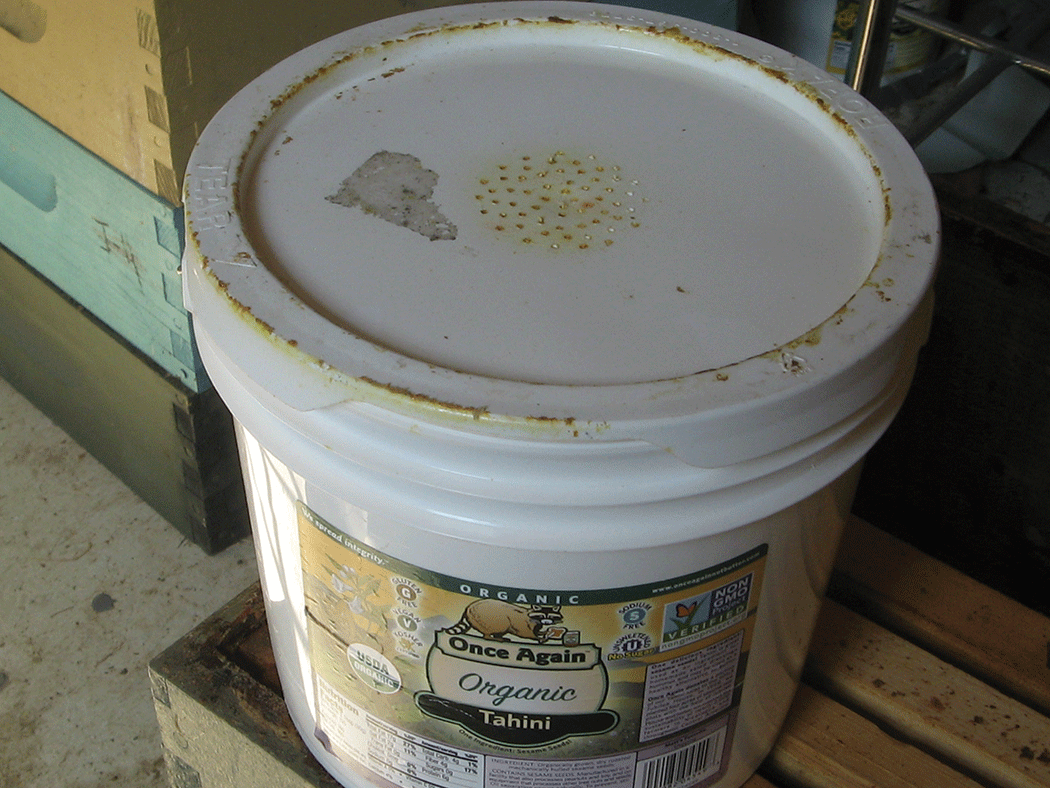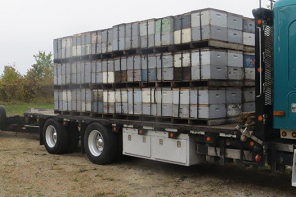By: Ross Conrad
In order to keep bees, you are not required to own or rent land. Often, landowners are happy to let you place
bees on their property in return for some honey and free pollination of their garden or crops. As a result, beekeeping is much more accessible to folks with limited incomes than just about all other agricultural activities. Avoiding the cost of bees and equipment is a bit more challenging however.
There is a lot of truth to the old saying that the way to make a small fortune in beekeeping is to start with a large fortune. Beekeeping catalogs are chock full of equipment, supplies, gadgets, and doohickeys for us to spend money on. Much of what fills the pages of the catalogs is optional however, and even the mandatory beekeeping items can be had, made, or substituted at low, or sometimes no cost. My intention with this article is to explore some cost saving ideas and stimulate your thinking about additional ways you can keep bees on a budget.
Honey Bees
Short of knowing a generous beekeeper that has too many hives and wants to give some away, perhaps the most obvious way to achieve savings on the procurement of honey bees is to catch a swarm. Swarm trapping is far easier than climbing up trees and ladders in order to capture swarms. For best results, research suggests that setting out a swarm trap with a volume of about 40-45 liters (about the size of a standard Langstroth deep hive body), with a very small entrance near the bottom of the hive, the entrance oriented to the south and the trap placed in a location about 15 feet off the ground will yield best results. Place a frame of drawn comb in the hive so the scent of the beeswax will catch the attention of scout bees. Alternatively, synthetic queen pheromone can be purchased and used as a swarm trap lure. Some folks like to use lemongrass essential oil on a cotton ball as a swarm lure since it contains at least two of the same chemicals that compose the honey bee Nasonov gland pheromone.
With the right tools and skills, the removal of swarms that have moved into buildings or other unwanted places can potentially provide both free bees, but some income as well. This is where a good quality ladder, a chainsaw or power tools can come in handy. A good source of information on this topic is Honey Bee Removal: A Step-by-Step Guide by Cindy Bee and Bill Owens.
Beekeeping Equipment
One of the best ways to save money is to not spend it in the first place. By foregoing optional equipment and limiting bee equipment purchases to necessary items only, both money and storage space can be saved. While each beekeeper is likely to have their own list of necessary items, as a starting point I would suggest the following be considered necessary items that one should not try keep bees without: Bottom board, hive body and honey supers with frames, inner cover, outer cover, smoker, hive tool and veil.
Another way to save a lot of money on bee equipment is to purchase pre-owned equipment from someone who is getting out of beekeeping. Just beware of purchasing old combs as they are notorious for harboring diseases and chemical residues that can adversely impact the health of your bees.
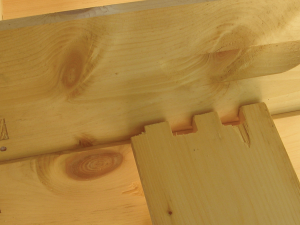
Purchase unassembled equipment to save money. To avoid knotty wood, wood tear outs around cut areas, cracks, and pre-drilled nail holes that are off-center or missing completely, buy premium grade hive parts – but it will cost you significantly more.
When purchasing equipment new, buy items that require assembly rather than equipment that is already assembled and painted in order to reap savings. Some equipment suppliers offer varying grades of equipment to choose from as well. You can save money when purchasing equipment by getting the “budget” or “economy” grade. This grade of equipment tends to be composed of parts that will work but are not ideal due to flaws in material and workmanship. Wooden parts that have knots, are cut to slightly the wrong dimension, have tear outs or splintered wood around cut edges, or have misaligned pre-drilled nailing holes are among the characteristics that will define budget or economy hive parts in contrast to the more expensive premium or select hive parts. Consider picking up orders rather than having them shipped for additional savings.
Another way to save on medium and shallow supers is to recycle old boxes by cutting down deep hive bodies that are damaged on the bottom and turn them into mediums or shallow supers. As long as the upper portion of the deep hive body is not damaged and the frame rest area is in good condition, a cut down box will make a great honey super. I always try to use an old or worn blade when cutting down old deep hive bodies into shallow supers, just in case I hit a nail in the process.
Another place where a significant amount of money can be saved is in the style of hive being chosen. For maximum savings, consider the relatively simplistic design of the top bar hive which requires less material, tools and skill to manufacture, but also calls for a different set of beekeeping management skills and knowledge to successfully keep bees alive especially in locations with long, cold Winters.
As suggested above, one place that I do not recommend you try to save money is on a hive tool. The money saved by using a screwdriver or knife when working hives is so little that it will not come anywhere close to making up for the damage you will do to your hive boxes and frames by prying on them with such tools. I also would not suggest you try to save money when it comes to protecting your bees from bears. Electric fences (especially solar powered ones) can be quite pricey, but depending on the number of hives in your apiary, the cost may be only a fraction of what the bees and equipment is worth.
Reusing old frames
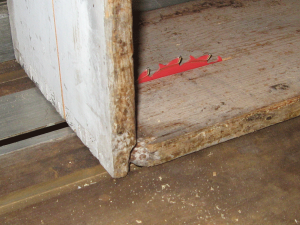
Cutting the lower part of a damaged deep or medium super to make a shallow super is one way to stretch out your equipment investment, use resources more efficiently and save money all at the same time.
When it comes to frames, money can be saved with the investment of time and good old-fashioned elbow grease in scraping down old frames and reusing them. You will need to invest $5 in a frame cleaner which has a thin end that is just the right size for cleaning beeswax and propolis out of bottom bar grooves and the pre-drilled holes in the end bars. Be sure to collect all the frame scrapings and render them down. You may be surprised by how much beeswax it will contain.
Foundation
In order to encourage bees to consistently build their comb within the frame and build it straight, it is best to use full sheets of foundation. Although it takes a bit more attention and effort to obtain straight combs when using starter strips of foundation, significant savings can be had when using one-inch foundation strips rather than full sheets.
There are two basic ways to use starter strips of foundation. One is to position the strip of foundation along the top bar. While top bar strips tend to work best in shallow or medium frames, there is a tendency for bees to stop building their comb just short of the frame’s sides and bottom. This results in a comb that is not well anchored and secured on the sides and bottom and is prone to breaking when handled the wrong way or blowing out when being extracted.
One alternative that helps to reduce this problem is to use foundation starter strips positioned against the end or side bars. Bees building comb from end bar starter strips anchor their comb firmly to the end bars, as well as the top bar, which greatly increases the overall strength and resilience of the comb during handling.
Another way that some beekeepers help to anchor the comb when allowing bees to build combs from starter strips is to position thin wooden dowels, or shish kabob skewers so they are imbedded within the comb when it is completed. Building on this idea, there are beekeepers who do away with the need to purchase foundation altogether and instead use wooden tongue depressors in place of foundation starter strips to help guide the comb building activities within the hive.
Positioning frames with starter strips or tongue depressors between two full frames of foundation, or two frames of straight drawn-out comb, and making sure that hive sits perfectly level, will go a long way to increasing the frequency that bees build comb that is straight.
Hive Stand
While a hive stand is highly recommended in order to keep hives off the wet, cold ground, money need not be spend when procuring one. Repurposed old bricks, cement blocks, scrap lumber, and flat rocks are among the items that can all serve as excellent hive stands.
Extractors
There is no getting around it; honey extractors are expensive. While hand-powered extractors cost less than extractors with electric motors, manual extractors are slower and this becomes an issue as the number of supers of honey you have to extract increase. Some backyard beekeepers will borrow a small extractor from a local beekeeper.
When buying an extractor, costs can be reduced by purchasing an extractor that has been preowned. Alternatively, some bee clubs and associations will purchase a small extractor for its membership to use, or several beekeepers in an area may decide to share the cost of purchasing an extractor to share among themselves. Consider producing cut comb honey, rather than liquid extracted honey, as a way to eliminate the high costs of extracting equipment.
Feeders
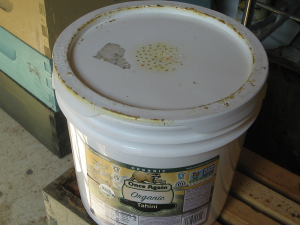
An empty container with a leak-proof lid such as this gallon-sized bucket can make a great honey bee feeder
There are numerous styles of feeders to choose from, some more expensive than others. For the budget conscious beekeeper, a simple feeder can be made at home out of a recycled pail or jar. When punching or drilling very small holes into the lid of the pail or jar, I like to nail or drill from the outside in. This way the ragged edges around the openings are on the inside of the container. Fill the container with bee feed and turn it upside down. The liquid syrup will drip out of the holes in the lid for about 20-30 seconds or so until a vacuum builds up inside the container. The vacuum will prevent the liquid from dripping any more until something touches the liquid through the holes and breaks the surface tension of the liquid. Place the feeder over the hole of the inner cover on the hive so the bees can access the feeder.
Coveralls
A full beekeeping suit is nice to have and certainly “official” looking, but for most practical purposes, I find that an old pair of light colored trousers and a light colored long sleeve shirt will work just as well as coveralls. Unfortunately there is no substitute for a good bee tight veil. There are however various styles to pick from when choosing a veil and some are more expensive than others. It pays to shop around.
Paint
To preserve your woodenware and save on paint costs, consider using off-color and returned paints and stains that are offered at a discount from our local paint store. By accepting whatever colors the store happens to have available, savings of 70%-80% or more can be achieved. Unless your apiary is located in southern or desert region where daytime temperatures may get up around 90°F or higher for months at a time and where hives painted white will keep bees the coolest, the bees won’t care about what color you paint their hive so why should you? As an additional bonus, evidence suggests that differentiating hives by painting them different colors, or painting unique shapes and designs around the entrances of hives can help the bees to recognize their hive over others and reduce drifting between colonies.
Smoker fuel
With a little pre-planning and effort, free smoker fuel can be obtained for beekeeping work. Whether it is wood shavings, dead pine needles, dried sumac berries, date palm thatch, used baling twine, dead leaves, mulch straw, or old burlap, abundant (and usually) free smoker fuel is available to those who take the time to seek it out – even in big cities. Whatever your source for smoker fuel, just be sure it is dry.
Keep your bees alive!
Probably the most important money saving tip that can be given is to keep your bees alive and healthy! Replacing bees is expensive. A strong, healthy colony of bees can make up and compensate for a lot of problems and issues. Think of any honey that you don’t harvest or money that you have to spend on preventing damage from mites, diseases, bears or nutritional stress as an investment rather than a cost. Strong populous colonies are also the best way to protect another one of the most important investments you have and that is drawn out beeswax combs. Frames of comb become vulnerable to wax moths and small hive beetles when not covered with honey bees so keep your equipment filled with bees. If only I had all the money I could have potentially saved if I had known about these ways to keep bees on a budget earlier on my beekeeping journey…
Ross Conrad is author of Natural Beekeeping: Organic Aproaches to Modern Apiculture, 2nd Edition. Ross will be leading a beginning beekeeping class on July 16-17, 2016 at Wildroots Farm in Bristol, VT for the Vermont Chapter of the Farmer Veteran Coalition. www.wildrootsfarmvermont.com








